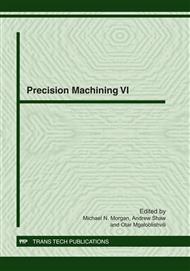p.80
p.86
p.92
p.98
p.104
p.110
p.115
p.121
p.127
Investigation of Thermally Treated Recyled Glass as a Vibratory Mass Finishing Media
Abstract:
This paper reports on the results of an experimental study in vibratory mass finishing. The machining performance of abrasive media produced entirely from recycled thermally treated glass is compared with that of conventional ceramic and polyester based media. Tests were completed in a vibratory trough machine over a range of work materials. It has been demonstrated that the recycled glass media can match the performance of conventional media in respect of surface finish (Ra), burr removal and ‘brightness’. The wear rate and self-attrition rate were also found to compare favourably with that of conventional media. The results of this study show considerable promise for the wider use of this highly innovative media.
Info:
Periodical:
Pages:
104-109
Citation:
Online since:
December 2011
Keywords:
Price:
Сopyright:
© 2012 Trans Tech Publications Ltd. All Rights Reserved
Share:
Citation:


